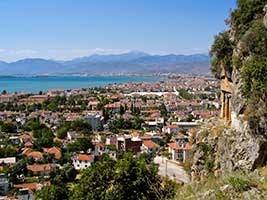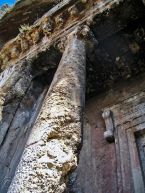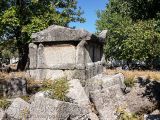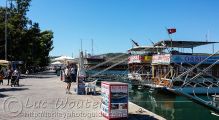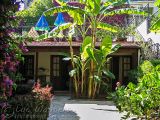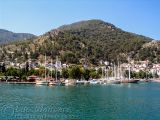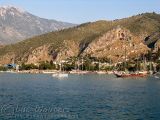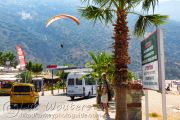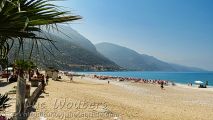Fethiye is a lively market town of about 60,000 inhabitants that has developed as one of the most important tourist destinations and holiday resorts on the Turquoise Coast.
History of Fethiye
Historically, Fethiye is built upon the ruins of the ancient city of Telmessos and possesses, as remnants of its past, some impressive rock tombs and a recently excavated Hellenistic theatre. However, the majority of the ruins remain still buried under the quaint town.
The town got its original name from Telmessos, the son of the god Apollo. Little is known about the early years of Telmessos, except that originally it wasn't part of the Lycian Federation. Actually, in the 4th century BC, the Lycians fought against the Telmessians and finally subdued Telmessos and brought it into the Lycian federation. Later Telmessos was captured by Alexander the Great, became part of the kingdom of Pergamon, and during the Roman imperial era, the city was part of the Lycian Federation.
Telmessos continued its existence into the Byzantine era but gradually lost its significance due to the Arab raids. In the 8th century, the city's name was changed to Anastasiopolis in honour of a Byzantine emperor and the following century it changed again to Makri meaning Far (City). Under the Ottoman rule, this was changed to Megri and finally, after the expulsion of the predominantly Greek population in the 1930s, it was named Fethiye after Tayyareci Fethi Bey (1887-1914), a local who was among Turkey's first pilots and was also a war hero.
Sights & Photos of Fethiye
Fethiye City
Fethiye suffered two immense earthquakes in 1857 and 1957 which toppled much of the town and completely destroyed the medieval town and the remains of antiquity. Throughout Fethiye, there are the scattered typical Lycian stone sarcophagi dating from around 450 BC. At the main quay at Liman Caddesi, there is the theatre that was excavated only since 1994. It had a capacity of 5,000 people and was built in the Early Roman period and renovated in the 2nd century AD.
Fethiye's most prominent monument is definitely the Amyntas tomb, thus called after the Greek inscription Amyntou tou Ermagiou (Armyntas son of Hermagios) carved on the wall of the tomb. This rock-cut tomb, an Ionic temple façade carved in the sheer rock face, stands out among similar temple tombs for its size. Whereas most such tombs are scarcely bigger than the height of an ordinary room (i.e. less than 2 meters internal, and less than 3 meters external), this tomb has the height of a full-size temple.
More contemporary monuments can be seen on the waterfront, near Fethiye's marina. The Şehit Teyyareci Yüzbaşı Fethı Bey Anıtı commemorates the heroism of captain Fethi Bey. Also on the waterfront there is the Şehitler Abidesi (Monument for the Martyrs), a memorial stele to the servicemen who died in recent conflicts.
https://www.turkeyphotoguide.com/fethiye?tmpl=component&print=1#sigProId89d7c343a3
12 Island Tour
The 12 Island tour or cruise can be considered as a reduced version of the famous weeklong Blue Cruise (Mavi Yolculuk). This one-day trip offers a relaxing day out by gulet the Bay of Fethiye. The boat sails along the beautiful Turquoise Coast and stops at about 4 little islands where there is ample opportunity to dive and swim in the clear blue waters of the secret coves and bays.
The main cultural highlight of the trip is the rock painting of a fish at Bedri Rahmi Cove. This small bay is called after Bedri Rahmi Eyüboğlu (1911-1975), a famous Turkish painter and poet who during the 1970s was a pioneer of the Blue Voyage and painted this fish in 1974.
https://www.turkeyphotoguide.com/fethiye?tmpl=component&print=1#sigProId68397ba7ed
Ölüdeniz
Ölüdeniz, meaning Dead Sea, is a lagoon and national park at about 15 km southeast of Fethiye. It is a place of outstanding beauty with a dazzling beach, azure sea and sheltered blue lagoon. The beach at Ölüdeniz ranks among the best beaches in the world. Unfortunately, much of the quiteness and original charm have been spoiled by package tourism. Ölüdeniz is a center for paragliding, where you can jump off the 1960 m high cliff of the Baba Dağ (Mount Baba). For the inexperienced, there are tandem paragliding flights, which are offered by several companies.
https://www.turkeyphotoguide.com/fethiye?tmpl=component&print=1#sigProId38b4a06b75
Travel Information & Travel Tips
Fethiye is a good basis for exploring Lycia and the remains of its ancient cities. From Fethiye, we visited the archaeological sites of Tlos, Kadyanda, and the ghost town Kayaköy.
We visited Fethiye in 2005, 2010, and 2014 while touring Lycia and stayed each time in the comfortable Hotel Villa Daffodil (Fevzi Çakmak Cad. No: 115, 48300 Fethiye, Tel: +90 252 6149595). The hotel serves excellent cuisine, has a very friendly and helpful staff and is located at a 20-30 min. walk out of the centre of town.
